Tom's Guide Verdict
The Razer Phone offers powerful performance, crazy-good audio and an innovative display, but the cameras and battery life disappoint.
Pros
- +
First 120-Hz Ultramotion display
- +
Best-in-class audio
- +
Great gaming performance
- +
Stays cool under pressure
Cons
- -
No headphone jack
- -
Screen could be brighter
- -
Cameras a step behind the competition
- -
Below-average battery life
Why you can trust Tom's Guide
In the decade I've covered Razer, I've learned one thing: never say never. I never would have thought the company would jump from peripherals to gaming laptops. But Razer did, and in a grand fashion and with solid success.
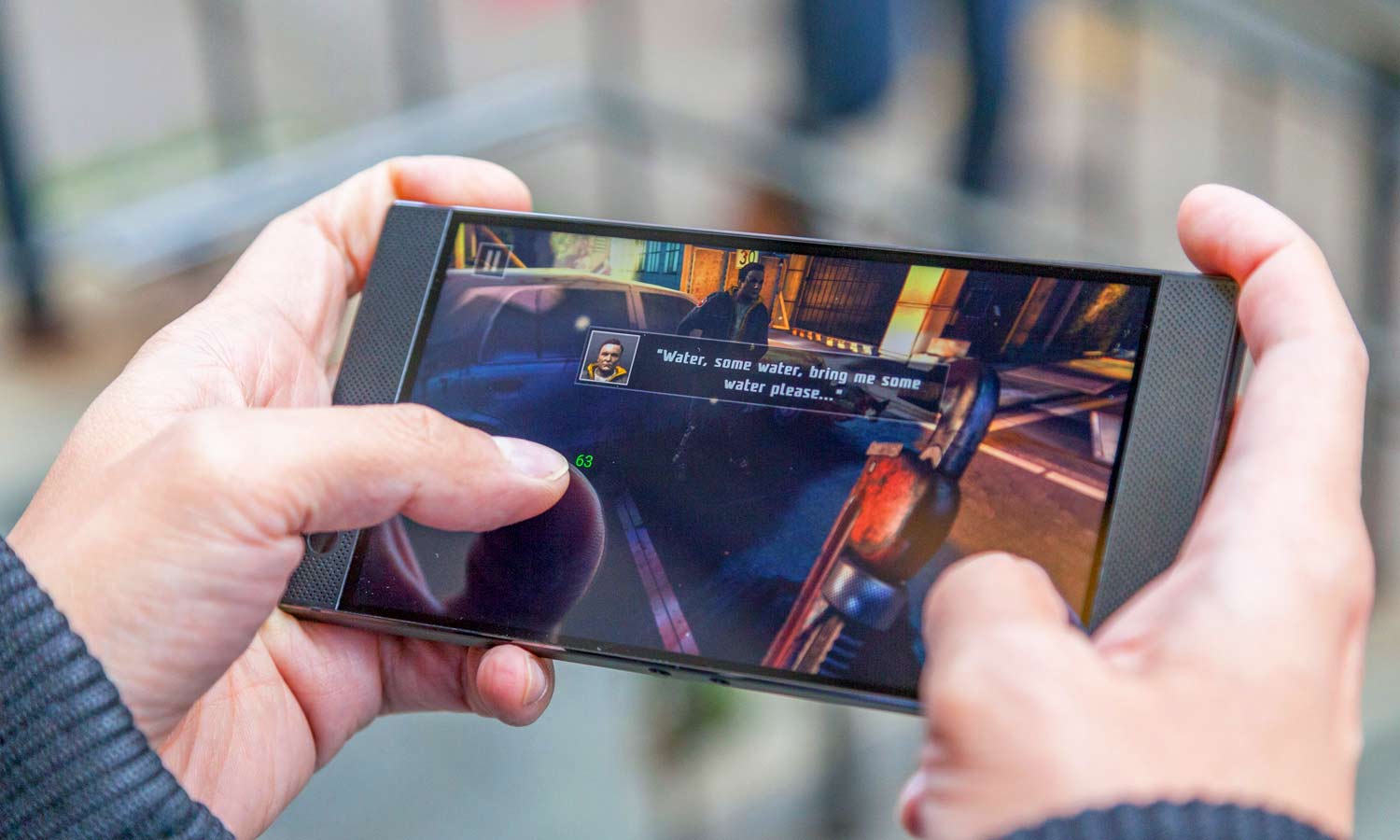
So I wasn't too surprised when the company announced the Razer Phone. Priced at $699, the unlocked phone packs in some impressive components, including 8GB of RAM and some of the best speakers I've heard on a smartphone. But the standout feature is the innovative 120-hertz Ultramotion display, a world's first for phones and something that truly enhances the gaming experience. However, the Razer Phone's battery life and camera quality trail comparably priced flagship phones.
Design: From Laptop to Smartphone
Thanks to premium materials and a sleek, iconic style, I've always been a big fan of Razer's laptops. That's why it's refreshing to see that the company incorporated many of those design notes into its first-ever smartphone. Just like the Blade, Blade Stealth and Blade Pro, the Razer Phone is made of the eternally lovely black CNC aluminum. But unlike the laptops with their rounded corners, the Phone has a more boxy shape, thanks to the influence of the Nextbit Robin, which Razer bought earlier this year.
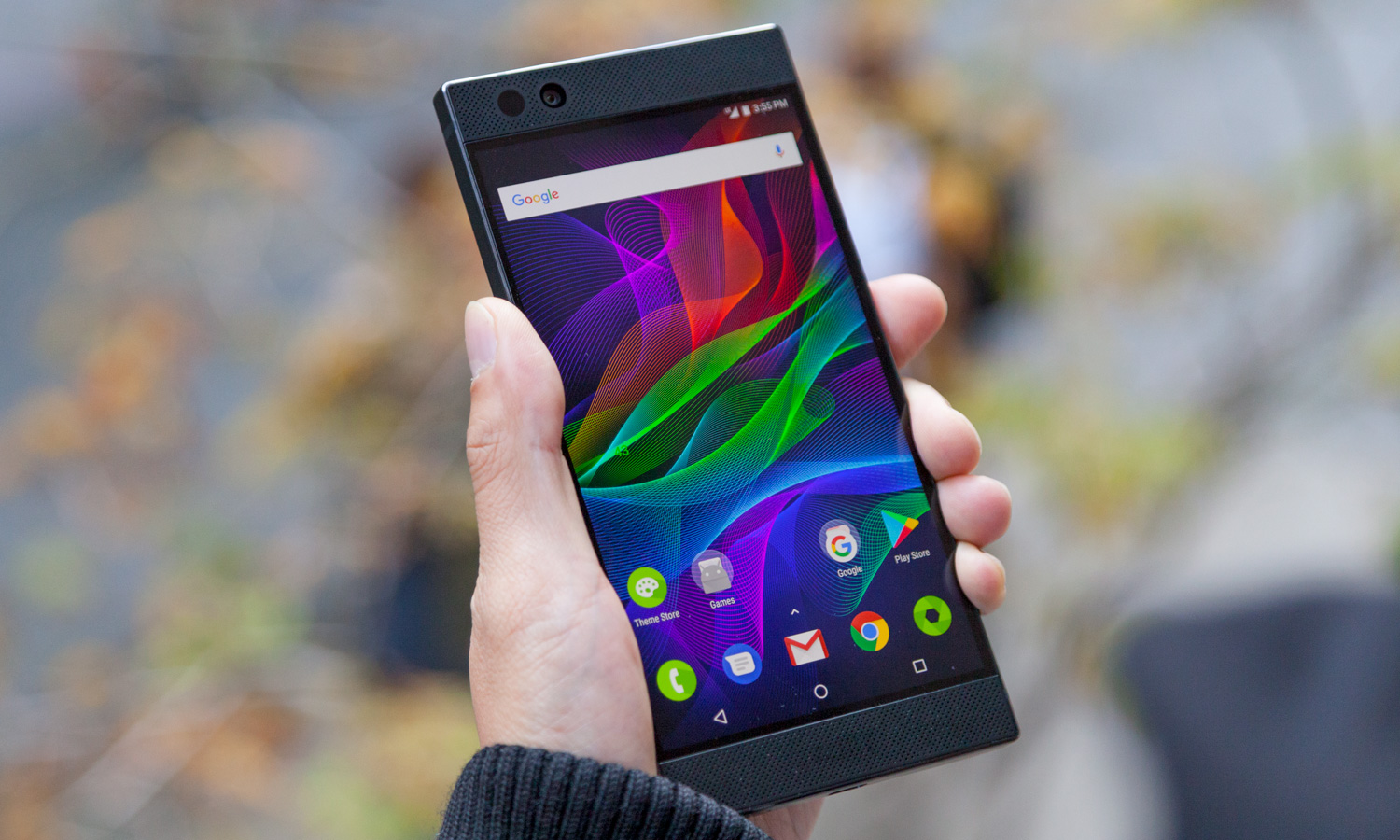
It was a decidedly polarizing look around the Tom's Guide's offices, but I really like it, especially the black embossed accents along the top, bottom and rear of the device and Razer's silver-lined, three-headed snake emblem. However, with slimmer, sleeker phones available such as as the Galaxy S8 and iPhone 8, the Razer Phone's boxy shape could be a harder sell for some, especially since it isn't water-resistant.
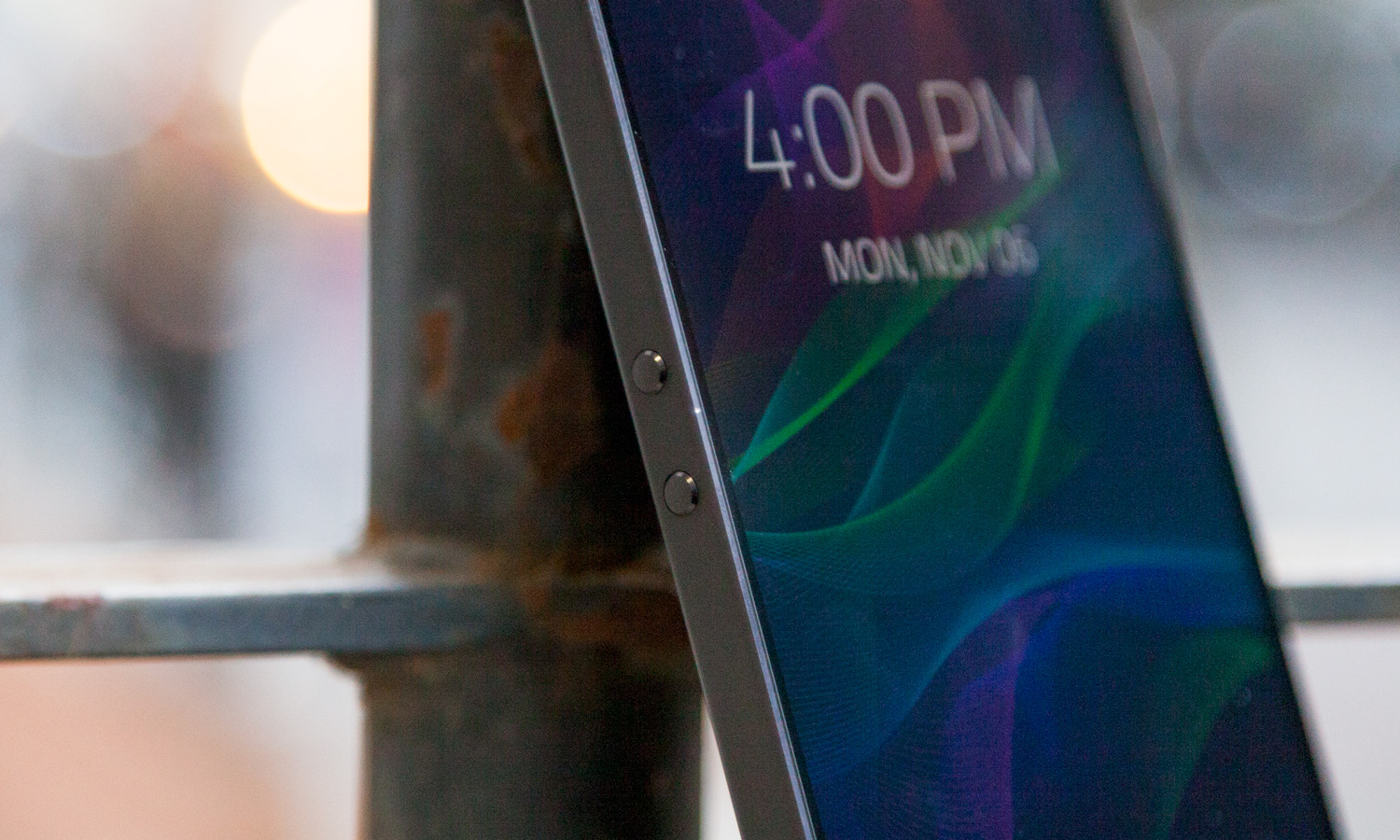
Like the Stealth, the Razer Phone isn't big on a lot of accoutrements. You'll find the microSD slot on the right with the glossy power button that doubles as a fingerprint reader. On the left are two round volume buttons. Along the bottom sits the USB Type-C port. The Razer Phone is the latest device to join the "no headphone jack" club. Although, when you've got speakers like these, you might not need a pair of buds.
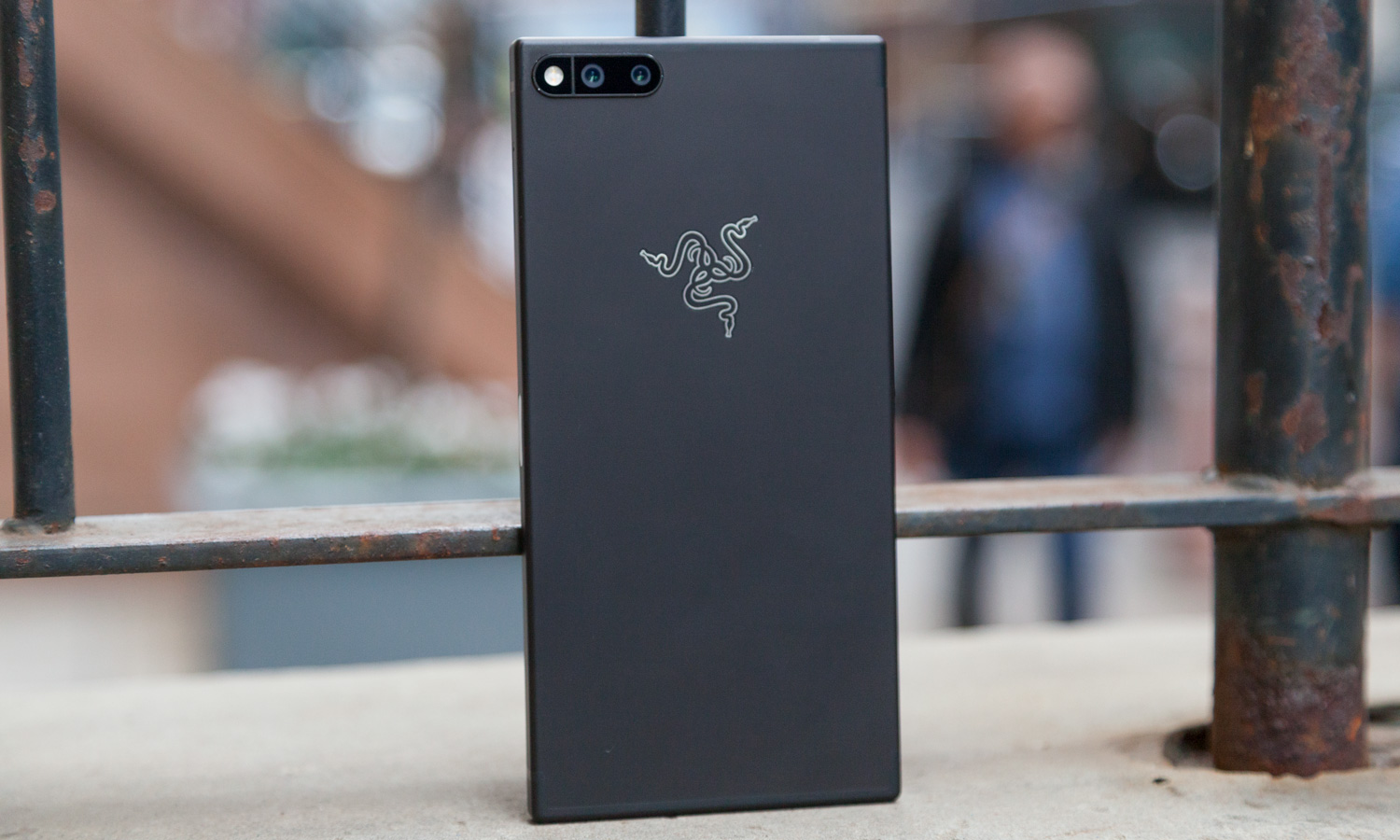
Flip the phone over on its back and you'll find a pair of 12-megapixel cameras with a flash in the top-right corner. On the front of the device, you get an 8-MP shooter with a flash embedded in one of the phone's large speakers, with the other resting right below the 5.7-inch display.
MORE: Best Smartphones on the Market Now
When it comes to weight, the Razer Phone is more Blade Pro than Stealth. The 6.2 x 3.1 x 0.3-inch device weighs a hefty 6.9 ounces. That's even heavier than the 6.2 ounce, 6.2 x 3 x 0.3-inch Google Pixel 2 XL, the Samsung Galaxy S8 (5.5 ounces, 5.9 x 2.7 x 0.3 inches) and the OnePlus 5 (5.4 ounces, 6.1 x 2.9 x 0.3 inches). However, the 6.2 x 3.1 x 0.3-inch Apple iPhone 8 Plus is a true heavyweight at 7.1 ounces.
Display
I expected a bit more from the Razer Phone's 5.7-inch QHD (2560 x 1440) Sharp IGZO display. It has undeniably rich color, but it's hamstrung by seriously dull backlighting. Nowhere was this more evident than when I watched the Pacific Rim 2 trailer. A monstrous Kaiju erupted from the ground, mouth agape with blue hellfire and malice. It was beautiful and terrifying, until I watched it side by side with my Samsung Galaxy S8+ and its Super AMOLED panel. On the Razer Phone, that ethereal blue maw looked dull and washed out.
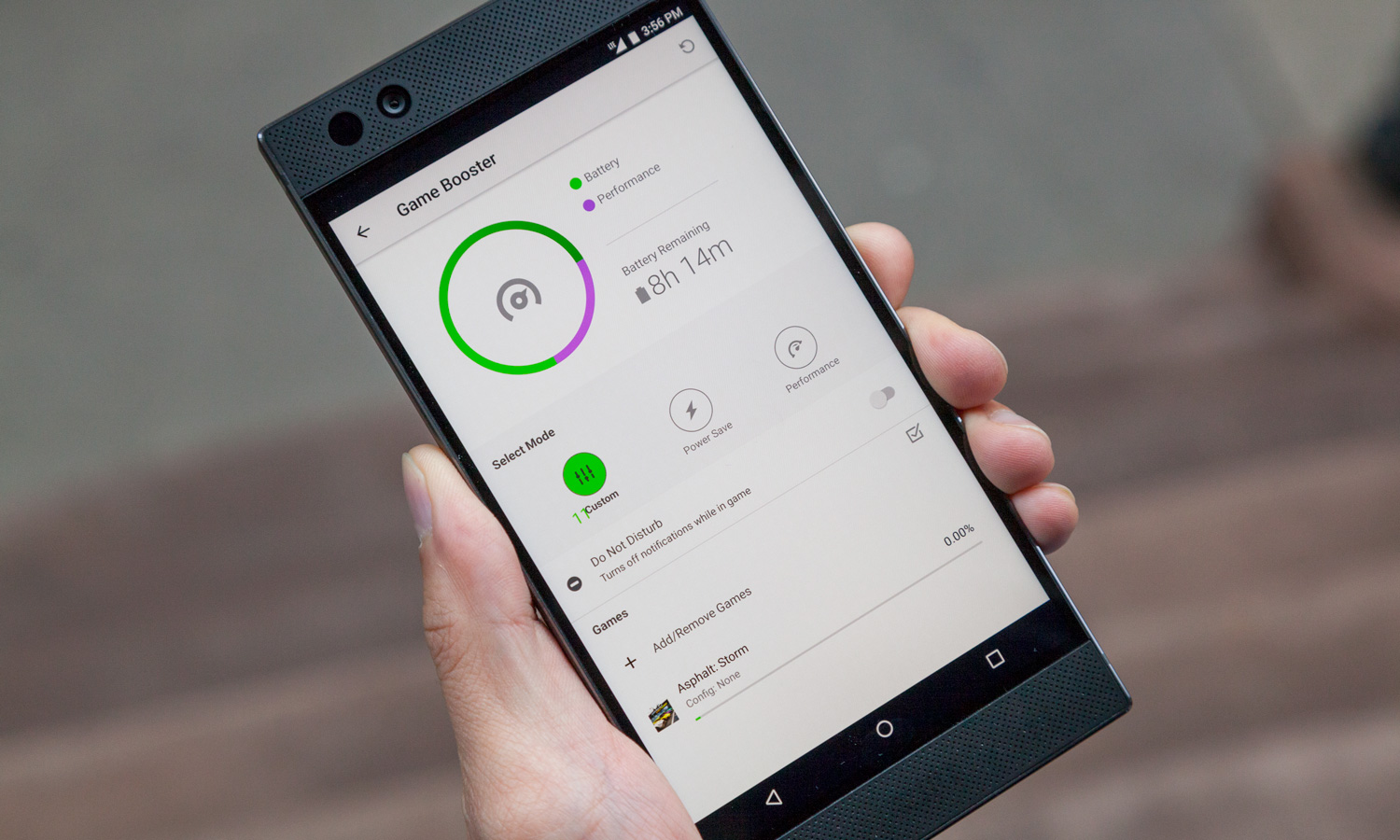
The device''s large bezels are another hit against the Razer Phone's panel.. In a world of Infinity Displays and notched, but bezelless screens, the black bars ensconcing the Razer Phone's display stick out like a sore thumb.
The Razer Phone's colorful presentation stems from its ability to reproduce 126 percent of the sRGB color gamut, which is better than the iPhone 8 Plus' 123 percent. As lovely as Razer's panel is, though, it falls short of the 156 percent smartphone average as well as the Pixel 2 XL (130 percent), Galaxy S8 (183 percent) and the OnePlus 5 (220 percent).
I expected more from the Razer Phone's 5.7-inch Sharp IGZO display. It has undeniably rich color, but it's on the dim side.
I'm disappointed that such a vivid display isn't brighter. The Razer Phone averaged only 310 nits, which is well below the 448-nit average. The OnePlus 5, GS8 and Pixel 2 XL were all brighter, with marks of 384, 437 and 438 nits, respectively.
Welcome to Ultramode
This wouldn't be a Razer device without some wild, gamer-centric innovation. For the Razer Phone, the company is rolling out its Ultramotion display, a proprietary display that delivers a 120-Hertz refresh rate — a world's first for smartphones. Similar to Nvidia's G-Sync technology, Ultramotion synchronizes the display refresh rate with the GPU render rate. The result is smoother graphics with little to no stuttering or lag.
When I played Asphalt Street Storm, I found myself in a white-knuckle race for pink slips. I floored the gas of my yellow Porsche and pulled ahead of my competition. I drifted into a sharp turn, narrowly missing the barricade as a mixture of sunlight and shadows ran across my car's chassis at 64 frames per second.
Audio: Hearing Is Believing
The Razer Phone has the best speakers I've ever heard on a smartphone. By far. The front-firing speakers are true powerhouses, and to hammer home that Razer aesthetic, the company took the mesh grille design from its laptops and used it on this phone. The grilles are a bit larger, and each speaker has its own amplifier. If that wasn't enough special sauce, the smartphone also has Dolby Atmos software preinstalled for legitimate 360-degree audio.
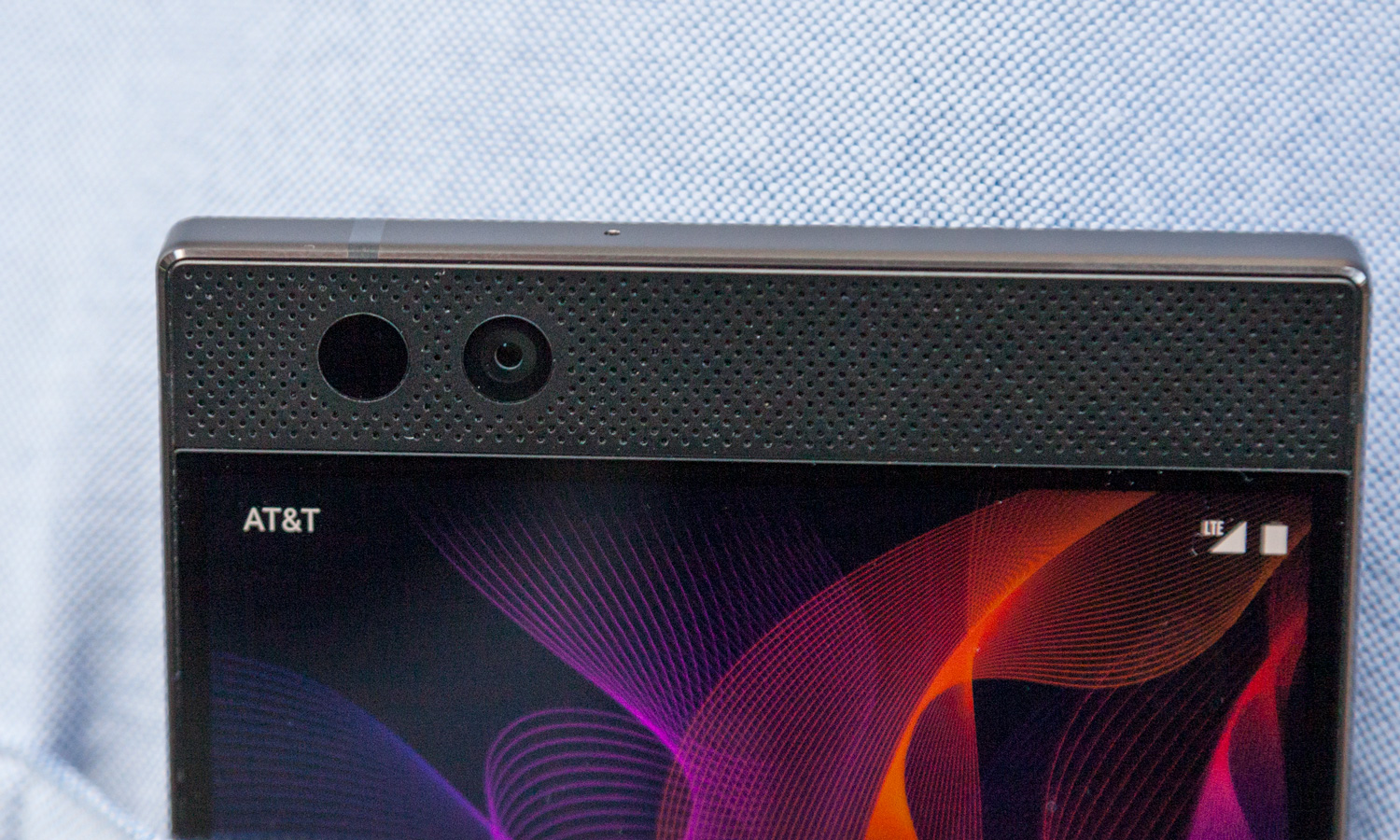
Honestly, the Razer Phone sounds better than most laptops, which feels weird to type. But when I launched Spotify, A Tribe Called Quest's "Find A Way" filled the confines of my bedroom. Q-Tip's unique voice was nice and clear, as were the snare and the hi-hat. The higher piano chords weren't distorted at max volume, and there was clear spacing between Phife Dawg's vocal and the soprano singing the hook. Despite the incredible volume, the lows weren't as forward as I expected them to be. I played the more bass-heavy "Drug Dealers Anonymous" to test my low-end theory, and while Pusha T and Jay-Z's vocals were crisp and acerbic on the track, the bass was a more subtle player.
MORE: Best Music Apps for Rocking Out
The Razer Phone also has THX certification, which you can only take advantage of via the 3.5-millimeter dongle bundled with phone. At 0.3 inches thick, Razer could have and should have added a headphone jack instead of forcing people into an unwanted #donglelife. As great as the Razer Phone sounds — and it does sound great — most people are going to be using headphones as they travel, especially someone like me who relies on the New York City subway. Yes, I have Bluetooth headphones, but I lose out on the THX secret sauce. Don't make me choose between charging and getting an optimal audio experience.
The Razer Phone has the best speakers I've ever heard on a smartphone. By far.
With or without the dongle, mobile games have never sounded so good. I was a little on edge as I ran and gunned my way through Dead Trigger 2, thanks to the never-ending sound of wet undead sloshing toward my position. The staccato from my MP5K submachine gun had real weight, as did the explosive barrels strategically placed throughout the boards.
Tailor Made for Gaming
Portrait mode is the de facto position for most handsets, but the Razer Phone isn't your typical handset. Pushed as an unabashed gaming device, the smartphone is Razer's answer to a rapidly growing appetite for mobile gaming. including Arena of Valor, a multiplayer online battle arena (MOBA) popular in Asia that's set to launch statewide in the near future. Razer sees a future where playing and streaming mobile games is just as popular as watching and playing Destiny 2 or Injustice 2.
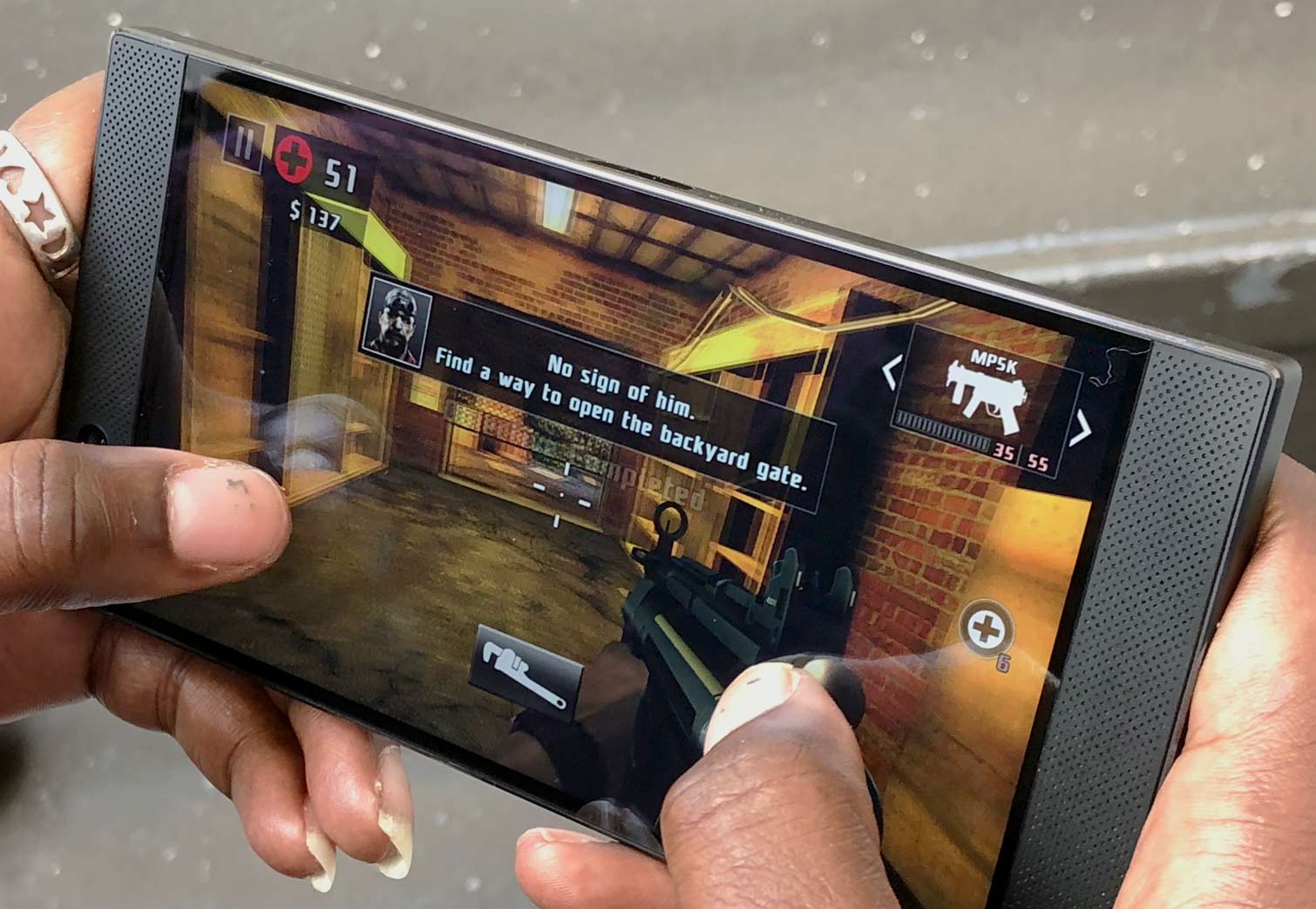
The phone is designed so nothing gets in the way of you and the game. The front-facing speakers are positioned so that your fingers don't inadvertently muffle that excellent audio. The power and volume rockers are located in places where you can't accidentally exit the game. It's just you, the phone and some seriously impressive frame rates.
When I played Dead Trigger 2, the frame rate didn't dip below 62 fps and at its highest reached 74 fps. The same title on my Galaxy S8 Plus scored betweenf 55 to 63 fps. Although both games ran smoothly, details like the gnarled tombstone-gray musculature of the hulking Titan monstrosity were sharper on the Razer Phone.
MORE: 20 Best Android Games
I saw similar results on Asphalt Street Storm, where the sun reflecting off my car's golden-yellow paint job looked more realistic compared to the GS8+. In terms of frame rates, the Razer Phone ranged between 55 to 68 fps, while the GS8 hovered between 52 to 62 fps.
Overall Performance
I've got to hand it to Razer: The performance on this thing is impressive. Even though I was running YouTube and Twitch in the background with five open tabs in Google Chrome, I didn't experience any lag when I was surfing web sites and navigating between home screens. The Razer Phone maintained its fluidity even after I launched Asphalt: Storm.
The Razer Phone also outpaced all its Android competition with its Qualcomm Snapdragon 835 processor and 8GB of RAM. The smartphone hit a multicore score of 6,685 on Geekbench 4, a synthetic test that measures overall performance, easily beating the 4,186 category average. Armed with their own Snapdragon 835s, the OnePlus 5, Pixel 2 XL and GS8 notched 6,542, 6,282 and 6,124, respectively. None of these phones were a match for the iPhone 8 Plus and its A11 Bionic processor, though, which scored an amazing 10,472.
As was expected, the Razer Phone nailed down fairly high marks on graphics tests. The handset delivered 41,526 on the 3DMark Ice Storm Unlimited benchmark, absolutely decimating the 21,385 average. The OnePlus 5 wasn't too far behind with 39,576, while the GS8 produced 35,903. But once again, the iPhone 8 Plus laid the epic smackdown with a score of 64,412.
Heat
Despite being sheathed in aluminum, the Razer Phone stays remarkably cool. Beneath that obsidian metal lies a heat pipe and some thermal shielding that funnels the heat to the exterior frame. That allows the heat to dissipate more quickly, making for a cooler phone overall.
MORE: Smartphones with the Longest Battery Life
I played Dead Trigger 2 for 30 minutes and the back of the phone became warmer over time, but not uncomfortably so. In fact, when I measured the rear panel with a heat gun, it registered 91 degrees Fahrenheit, which is just below our 95-degree comfort threshold.
Battery Life
At 4,000 mAh, the Razer Phone has one of the largest batteries I've tested. That didn't necessarily help it during our battery test. After surfing the web over AT&T's 4G LTE network at 150 nits of screen brightness, the smartphone tapped out after 9 hours and 30 minutes. That's just short of the 9:41 smartphone average. However, when we adjust the display's refresh rate to 60Hz instead of the default 90Hz, the time jumped to 10:35.
The Razer Phone has one of the largest batteries we've tested, but that didn't help it on our battery test.
Still. the iPhone 8 Plus lasted a much longer 11:16, while the GS8 ran 10:39. The Pixel 2XL and OnePlus 5 clocked in at 12:09 and 13:06, respectively.
Cameras: No Frills Whatsoever
The Razer Phone has a dual camera in the style of the iPhone 8 Plus. But before you start primping and preening for those Portrait Lighting and Contour shots, know that the phone lacks any notable camera features, outside of an optical zoom. In terms of features, it's one of the most vanilla camera apps I've ever used. There's not even a dedicated button for optical zoom; you have to pinch to zoom and guess what's 2x.
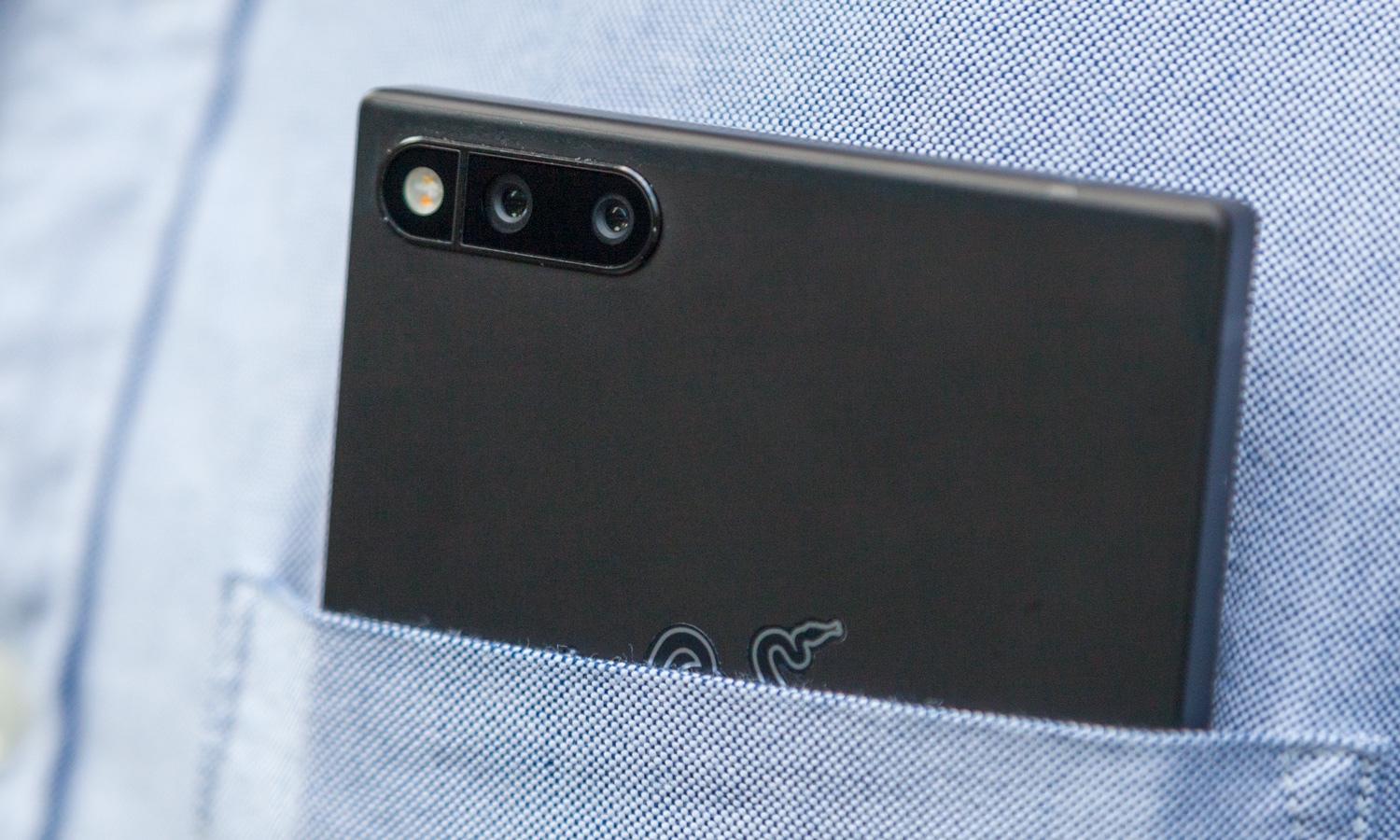
While you can adjust the exposure and contrast, there are no Pro settings if you want to futz around with the white balance or ISO. You do get HDR (high dynamic range), but it takes the camera 2 to 3 seconds to capture a photo when it's enabled. That feels like a lifetime, especially when I was trying to get a shot of my dog. By the time it snapped, he had moved and I was left with a blurry mess of a photo.
I pitted the Razer Phone against my Samsung Galaxy S8+ in a mini camera face-off, and the Samsung has the edge.
When I shot a mural of Sojourner Truth on a school in my neighborhood, the Razer Phone delivered richer color than did my GS8 Plus, whose images looked a tad washed out. However, the GS8 Plus had better detail, like tiny cracks in the paint and the ridges caused by the depressions in the brick.
I saw a similar result in a natural-light shot I took of two of my colleagues. The Razer Phone adjusted better to the lighting, producing more realistic color, but the GS8 Plus caught the finer details like flyaway hairs. There was also more grain when I zoomed in on the Razer Phone's shot.
The Razer Phone hit a major roadblock in low light.
When I dimmed the lights, the camera only focused on one face and took 2 to 3 seconds to capture the shot. The end result was a dark, grainy image with hardly any detail and muted color. The GS8 Plus was like day to the Razer Phone's light, once again delivering sharp detail.
When I switched to the Razer's front-facing 8-MP shooter, I found that because the camera had trouble adjusting to the light, there was a greenish pall over the image. As a result, my skin looked ashen and my orange-and-purple locs looked brown. The GS8 Plus' image produced a more accurate skin tone and came closest to showing off my purple hair.
While both the rear- and front-facing cameras can capture video in 4K, don't expect any fancy-schmancy features. Sample videos I took during the New York City Marathon showed the Razer did a better job with color reproduction than the Samsung G8 Plus, while the latter showed off more detail, like hairs matted to the runners' heads by rain and sweat. Despite holding both phones precariously in one hand, neither video suffered from my fumbling. In fact, I couldn't make out much shaking, if any at all, in either video.
Interface: Not Quite Vanilla
Even though I own a Galaxy S8 Plus with all its TouchWiz bells and whistles, there's something to be said for the unadulterated freedom that comes with semi-vanilla Android. I say semi, because Razer added one notable touch to the interface with its Game Booster.
Designed to allow gamers to optimize their games with a focus on extending battery life and improving overall performance while playing, Game Booster is similar to the Game Optimization and BatteryBoost features found in Nvidia's GeForce Experience suite or the Samsung Game Tuner app. Razer gives you the option of creating your own custom settings or switching between Power Save and Performance modes.
MORE: Android Tips to Unlock Your Phone's Full Potential
Aside from that, the Razer phone delivers a fairly unadulterated Android experience. The best part about Android is that it's not slowed down by layers of skinned interfaces. I whipped through menus and home screens with the greatest of ease on the Razer Phone's Android 7.1.1 (Nougat) interface without nary an encounter with latency.
It would have been nice if the phone were shipping with Oreo (Android 8.0), but I guess we'll have to wait until the first part of Q1 2018 for the pleasure.
Bottom Line
After several days with the Razer Phone, I'm still not totally convinced that I need a bona fide gaming phone. But Razer makes a pretty strong case with its Ultramotion display, great frame rates and stunning audio.. However, this $699 handset has some drawbacks, including a camera that's poor in low light, the lack of a headphone jack and a screen that simply doesn't dazzle like OLED. And while I was relieved to see the phone's battery life can be extended by adjusting the refresh rate, I'm not sure most people will remember or bother to do it.
If you're in the market for an unlocked phone and want snappy performance for an affordable price, we would suggest holding out for the OnePlus 5T, which debuts Nov. 16. The Galaxy S8+ isn't as fast when gaming, but it offers better cameras, a more dazzling Infinity Display and longer endurance. Overall, the Razer Phone is a bold first step for the company, but it's not a slam dunk.
Credit: Shaun Lucas/Tom's Guide
Sherri L. Smith has been cranking out product reviews for Laptopmag.com since 2011. In that time, she's reviewed more than her share of laptops, tablets, smartphones and everything in between. The resident gamer and audio junkie, Sherri was previously a managing editor for Black Web 2.0 and contributed to BET.Com and Popgadget.

